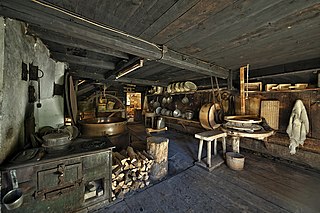
A dairy is a place where milk is stored and where butter, cheese and other dairy products are made, or a place where those products are sold. It may be a room, a building or a larger establishment. In the United States, the word may also describe a dairy farm or the part of a mixed farm dedicated to milk for human consumption, whether from cows, buffaloes, goats, yaks, sheep, horses or camels.

A barn is an agricultural building usually on farms and used for various purposes. In North America, a barn refers to structures that house livestock, including cattle and horses, as well as equipment and fodder, and often grain. As a result, the term barn is often qualified e.g. tobacco barn, dairy barn, cow house, sheep barn, potato barn. In the British Isles, the term barn is restricted mainly to storage structures for unthreshed cereals and fodder, the terms byre or shippon being applied to cow shelters, whereas horses are kept in buildings known as stables. In mainland Europe, however, barns were often part of integrated structures known as byre-dwellings. In addition, barns may be used for equipment storage, as a covered workplace, and for activities such as threshing.

Animal husbandry is the branch of agriculture concerned with animals that are raised for meat, fibre, milk, or other products. It includes day-to-day care, management, production, nutrition, selective breeding, and the raising of livestock. Husbandry has a long history, starting with the Neolithic Revolution when animals were first domesticated, from around 13,000 BC onwards, predating farming of the first crops. During the period of ancient societies like ancient Egypt, cattle, sheep, goats, and pigs were being raised on farms.
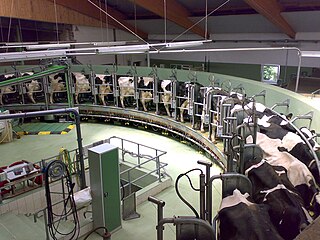
Dairy farming is a class of agriculture for the long-term production of milk, which is processed for the eventual sale of a dairy product. Dairy farming has a history that goes back to the early Neolithic era, around the seventh millennium BC, in many regions of Europe and Africa. Before the 20th century, milking was done by hand on small farms. Beginning in the early 20th century, milking was done in large scale dairy farms with innovations including rotary parlors, the milking pipeline, and automatic milking systems that were commercially developed in the early 1990s.

A stable is a building in which livestock, especially horses, are kept. It most commonly means a building that is divided into separate stalls for individual animals and livestock. There are many different types of stables in use today; the American-style barn, for instance, is a large barn with a door at each end and individual stalls inside or free-standing stables with top and bottom-opening doors. The term "stable" is additionally utilised to denote a collection of animals under the care of a single owner, irrespective of their housing or whereabouts.

Dairy cattle are cattle bred with the ability to produce large quantities of milk, from which dairy products are made. Dairy cattle generally are of the species Bos taurus.

A halter or headcollar is headgear placed on animals used to lead or tie up livestock and, occasionally, other animals; it fits behind the ears, and around the muzzle. To handle the animal, usually a lead rope is attached. On smaller animals, such as dogs, a leash is attached to the halter.

A horse blanket or rug is a blanket or animal coat intended for keeping a horse or other equine warm or otherwise protected from wind or other elements. They are tailored to fit around a horse's body from chest to rump, with straps crossing underneath the belly to secure the blanket yet allowing the horse to move about freely. Most have one or two straps that buckle in front, but a few designs have a closed front and must be slipped over a horse's head. Some designs also have small straps that loop lightly around the horse's hind legs to prevent the blanket from slipping sideways.

A barnyard or farmyard is an enclosed or open yard adjoining a barn, and, typically, related farm buildings, including a farmhouse. Enclosed barnyards are usually formed by a combination of fences and farm structures.

There are many aspects to horse management. Horses, ponies, mules, donkeys and other domesticated equids require attention from humans for optimal health and long life.
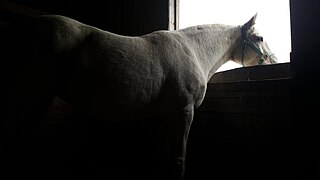
Weaving is a behaviour in horses that is classified as a stable vice, in which the horse repetitively sways on its forelegs, shifting its weight back and forth by moving the head and neck side to side. It may also include swaying of the rest of the body and picking up the front legs. Some horses exhibit non-stereotypical weaving, and instead engage in variations on this behavior.

Automatic milking is the milking of dairy animals, especially of dairy cattle, without human labour. Automatic milking systems (AMS), also called voluntary milking systems (VMS), were developed in the late 20th century. They have been commercially available since the early 1990s. The core of such systems that allows complete automation of the milking process is a type of agricultural robot. Automated milking is therefore also called robotic milking. Common systems rely on the use of computers and special herd management software. They can also be used to monitor the health status of cows.

A livery yard, livery stable or boarding stable, is a stable where horse owners pay a weekly or monthly fee to keep their horses. A livery or boarding yard is not usually a riding school and the horses are not normally for hire. Facilities at a livery yard normally include a loose box or stable and access for the horse to graze on grass.
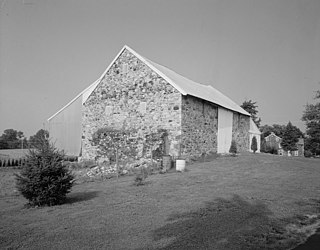
A bank barn or banked barn is a style of barn noted for its accessibility, at ground level, on two separate levels. Often built into the side of a hill or bank, the upper and the lower floors could be accessed from ground level, one area at the top of the hill and the other at the bottom. The second level of a bank barn could also be accessed from a ramp if a hill was unavailable.
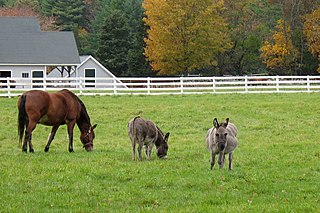
Stable vices are stereotypies of equines, especially horses. They are usually undesirable habits that often develop as a result of being confined in a stable with boredom, hunger, isolation, excess energy, or insufficient exercise. They present a management issue, not only leading to facility damage from chewing, kicking, and repetitive motion, but also leading to health consequences for the animal if not addressed. They also raise animal welfare concerns.

An equestrian facility is created and maintained for the purpose of accommodating, training or competing equids, especially horses. Based on their use, they may be known as a barn, stables, or riding hall and may include commercial operations described by terms such as a boarding stable, livery yard, or livery stable. Larger facilities may be called equestrian centers and co-located with complementary services such as a riding school, farriers, vets, tack shops, or equipment repair.

This is a basic glossary of equestrian terms that includes both technical terminology and jargon developed over the centuries for horses and other equidae, as well as various horse-related concepts. Where noted, some terms are used only in American English (US), only in British English (UK), or are regional to a particular part of the world, such as Australia (AU).
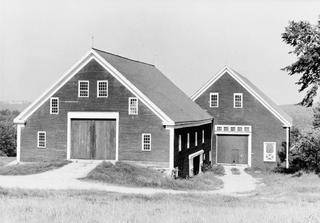
The New England Barn was the most common style of barn built in most of the 19th century in rural New England and variants are found throughout the United States. This style barn superseded the ”three-bay barn” in several important ways. The most obvious difference is the location of the barn doors on the gable-end(s) rather than the sidewall(s). The New England and three bay barns were used similarly as multipurpose farm buildings but the New England barns are typically larger and have a basement. Culturally the New England Barn represents a shift from subsistence farming to commercial farming thus are larger and show significant changes in American building methods and technologies. Most were used as dairy barns but some housed teams of oxen which are generally called teamster barns. Sometimes these barns are simply called “gable fronted” and “gable fronted bank barns” but these terms are also used for barns other than the New England style barn such as in Maryland and Virginia which is not exactly the same style as found in New England. A similar style found in parts of the American mid-west and south is called a transverse frame barn or transverse crib barn.
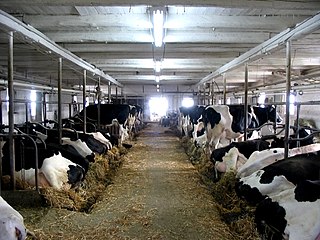
Tie stalls, also known as stanchion or stall barn, are a type of stall where animals are tethered at the neck to their stall. It is mostly used in the dairy industry, although horses might also be stalled in tie stalls. Typically, the barn has two rows of stalls, where the cow is tied up for resting, feeding, milking and watering. This type of housing is used in both regular and organic farming.
A compost bedded pack barn (CBP) is a type of housing for dairy cattle. It is a loose housing system, similar to free-stall housing, except there are no stalls or partitions.




















